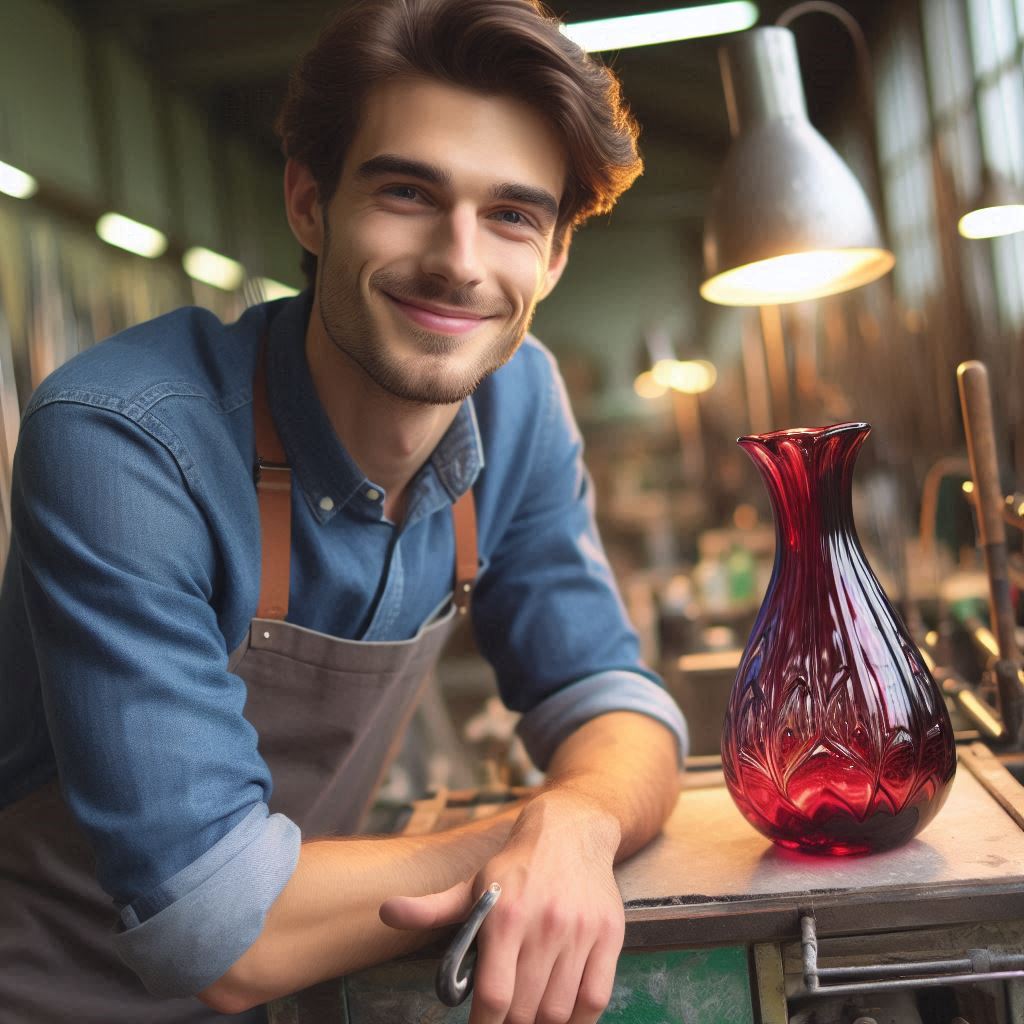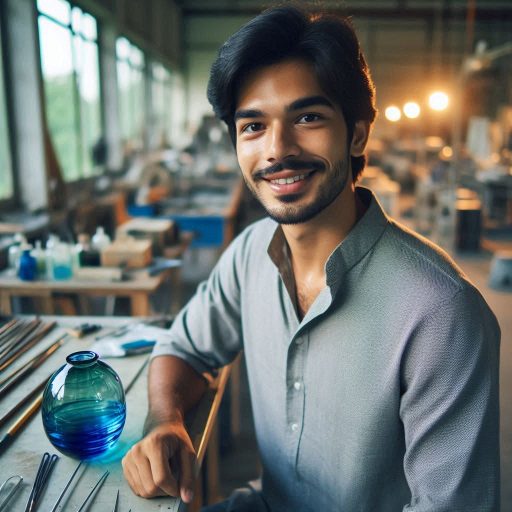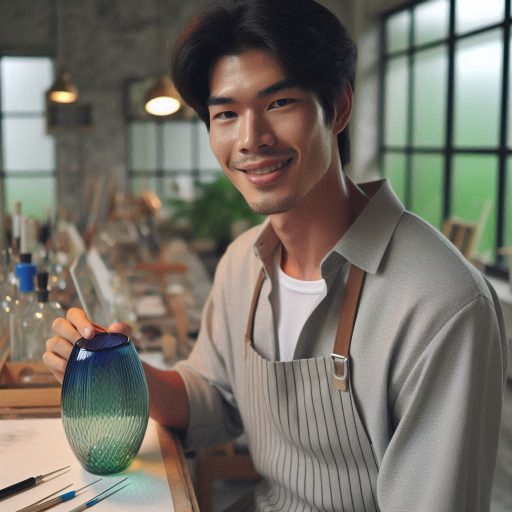Introduction
Glass art has a rich history dating back thousands of years.
It has been used for both functional and decorative purposes throughout the ages.
Exploring modern trends in glass art is crucial to keeping the art form relevant and innovative.
Artists are constantly pushing boundaries, creating new techniques and styles.
In recent years, the glass art industry has experienced significant growth.
There is a renewed interest in this unique medium, leading to more opportunities for artists and collectors.
Evolution of Techniques
Traditional glassmaking techniques date back centuries, involving processes like blowing and casting.
Modern technology, such as kilns and advanced tools, has revolutionized the field of glass art.
Contemporary glass artists are constantly pushing boundaries with innovative techniques like glass fusing and slumping.
Traditional Glassmaking Techniques
Glassblowing is a classic technique where molten glass is inflated using a blowpipe to create various shapes.
Casting involves pouring molten glass into a mold, allowing artists to replicate intricate designs with precision.
Stained glass art, known for its use in windows and mosaics, involves assembling colored glass pieces to form intricate patterns.
Impact of Modern Technology
Advanced kilns have made it possible to precisely control the temperature and shaping of glass, allowing for greater artistic freedom.
Tools like diamond saws and sandblasters enable artists to cut and etch glass with extreme precision, creating detailed designs.
3D printing technology has opened up new possibilities for creating intricate glass sculptures and artworks with precise dimensions.
Innovative Techniques by Contemporary Glass Artists
Glass fusing involves melting multiple glass pieces together at high temperatures to create unique textures and patterns.
Glass slumping techniques allow artists to shape molten glass into curved or molded forms, adding dimension to their creations.
Electroforming is a technique where metal is plated onto glass, adding a metallic finish and enhancing the visual appeal of the artwork.
Read: Essential Tools for Glass Artists
Emerging Artists
As the world of modern glass art continues to evolve, it’s crucial to shine a spotlight on the up-and-coming artists who are making their mark on the industry.
Transform Your Career Today
Unlock a personalized career strategy that drives real results. Get tailored advice and a roadmap designed just for you.
Start NowFeature profiles of up-and-coming glass artists
- John Smith: A young artist known for his experimental approach to glassblowing, combining traditional techniques with contemporary aesthetics.
- Jane Lincoln: With a background in sculpture, Jane’s work blurs the lines between art and design, creating functional yet visually striking pieces.
- Alexander Wang: Drawing inspiration from nature, Alexander’s glass art pieces evoke a sense of organic beauty and fluidity.
Their unique styles and influences
Each of these emerging artists brings a distinct style and set of influences to their work, contributing to the diversity and richness of the modern glass art scene.
John Doe’s fascination with geometry and light is evident in his intricate glass sculptures, which play with reflections and refractions to create mesmerizing patterns.
Jane Smith draws from sculpture to shape her glass art.
Her pieces blur lines between sculpture and functional design.
She challenges traditional views of what glass art is.
Alexander Wang reflects his deep connection to nature in designs.
He uses organic forms and natural color palettes throughout.
Each piece uniquely captures nature‘s essence in captivating ways.
How these artists are pushing boundaries in the industry
Emerging artists embrace new techniques, materials, and conceptual approaches.
They push modern glass art beyond its traditional boundaries.
These artists constantly redefine what‘s possible in the field. Their innovations shape the future of glass art.
John Doe challenges traditional glassblowing craftsmanship and technique.
He pushes the boundaries of what glassblowing can achieve.
His experimental approach redefines the possibilities within the medium.
Jane Smith fuses art and design, challenging established categorizations.
She pushes viewers to rethink preconceived ideas about glass art.
Her work reshapes how people view its purpose and function.
Alexander Wang pushes boundaries with his innovative glass art.
He uses color and form to create visually stunning pieces.
His works challenge traditional ideas in the glass art world.
Each creation captivates with its beauty and conceptual depth.
Emerging artists actively shape the vibrant landscape of modern glass art.
They push boundaries and inspire future generations to do the same.
These artists explore new possibilities in this evolving and dynamic field.
Their work paves the way for continued innovation in glass art.
Read: Famous Glass Artists and Their Works
Sustainability in Glass Art
As the world becomes more aware of environmental issues, sustainability in glass art has become a crucial aspect to consider.
The Importance of Sustainability in Glass Art
Sustainable glass art reduces environmental impact during production.
Artists must prioritize eco-friendly practices throughout the process.
They can minimize waste by using recycled materials.
Energy-efficient furnaces also cut down on emissions.
After creation, proper disposal methods further reduce harm.
This ensures glass art remains environmentally responsible in every stage.
Eco-Friendly Practices Adopted by Glass Artists
- Recycling glass: Artists often use recycled glass to create their artwork, reducing the need for new raw materials.
- Reducing waste: Glass artists aim to minimize waste during the production process by reusing materials whenever possible.
- Using non-toxic materials: Eco-conscious artists opt for non-toxic materials to ensure their artworks are environmentally friendly.
- Utilizing sustainable techniques: Artists explore sustainable techniques like solar-powered kilns to reduce their carbon footprint.
Examples of Sustainable Glass Art Projects
Several glass artists have embraced sustainability in their work, creating stunning pieces while minimizing environmental impact.
- Chihuly Garden and Glass: Dale Chihuly’s sustainable glass art installations incorporate recycled materials and energy-efficient lighting.
- Studio Swine’s Can City: This project transforms aluminum cans into glass sculptures, highlighting the beauty of recycled materials.
- Turning sea glass into art: Artists collect discarded sea glass and transform it into beautiful artworks, giving new life to ocean waste.
- Community glass recycling programs: Some artists collaborate with communities to collect and recycle glass for art projects, promoting sustainability.
In fact, sustainability in glass art is not only important for protecting the environment but also for inspiring creativity and innovation in the art world.
Read: How to Start a Career as a Glass Artist

Fusion of Traditional and Contemporary Styles
How modern glass artists are incorporating traditional techniques into their work
Modern glass artists revitalize traditional techniques.
They infuse history into contemporary pieces.
Their work showcases craftsmanship and innovation.
This blend creates unique artistic expressions.
Each piece reflects a deep appreciation for heritage.
Artists experiment with materials and methods.
Their creations bridge past and present seamlessly.
This fusion captivates audiences and inspires new discussions.
Blending of different styles and influences in contemporary glass art
Contemporary glass art blends various styles and influences.
Artists create a dynamic and diverse landscape.
This innovation reshapes the art world continuously.
Each piece reflects unique artistic expressions. Viewers experience a rich visual tapestry.
The medium inspires creativity and experimentation. New techniques emerge, pushing boundaries further.
This evolution captivates audiences worldwide.
Artists are successfully merging traditional and modern elements by experimenting with new materials and technologies while honoring age-old practices.
Examples of Fusion in Glass Art
- Dale Chihuly combines ancient Murano glassblowing techniques with sleek, minimalist designs.
- Judith Schaechter intertwines intricate stained glass patterns with bold, abstract forms.
- Mauro Bonaventura fuses delicate filigree work with cutting-edge 3D printing technology.
These fusion pieces not only showcase the artist’s skill and creativity but also bridge the gap between past and present, tradition and innovation.
Read: Art and Design Collaborations: Benefits and Challenges
Popularity of Installation Art
Rise of installation art in the glass art world
Installation art has seen a significant rise in popularity within the glass art world.
Artists are embracing this medium to create immersive experiences that captivate audiences and push the boundaries of traditional art forms.
One of the reasons for the growing popularity of glass art installations is the unique ability of glass to interact with light.
Glass installations can create stunning reflections and refractions that add an element of dynamic movement to the artwork.
How artists are creating immersive experiences with their glass installations
Artists are experimenting with different techniques and processes to create innovative glass installations that challenge the viewer’s perception and perspective.
By playing with transparency, opacity, and color, artists are able to create visually striking pieces that evoke emotion and intrigue.
Notable Examples of Successful Glass Art Installations
- Dale Chihuly: Known for his large-scale glass sculptures and installations, Chihuly’s work has been exhibited in museums and public spaces around the world.
His vibrant and intricate pieces often draw inspiration from nature. - Martin Janeck‘: This Czech glass artist is renowned for his intricate glass sculptures and installations that explore themes of fragility and beauty.
His work often combines traditional glassblowing techniques with modern design concepts. - Choi Jeong Hwa: A South Korean artist known for his vibrant and playful installations, Choi Jeong Hwa uses everyday objects like plastic bottles and kitchen utensils to create larger-than-life pieces that challenge perceptions of beauty and art.
- Sabine Marcelis: A Dutch designer who works with glass, Sabine Marcelis creates minimalist and elegant installations that play with light and color.
Her use of geometric shapes and sleek finishes adds a contemporary touch to her work. - Maya Lin: While primarily known as an architect, Maya Lin has also created stunning glass art installations that reflect her interest in the environment and sustainability.
Her pieces often incorporate natural elements like water and light to create immersive experiences for viewers.
Overall, the rise of installation art in the glass art world has opened up new possibilities for artists to express their creativity and engage with audiences in unique ways.
By creating immersive experiences that combine light, color, and form, artists are pushing the boundaries of what is possible with glass as a medium.
Collaborations and Exhibitions
Collaborations play a vital role in the glass art community as they bring together different perspectives and talents.
Artists are now teaming up with other creatives such as architects, designers, and even scientists to create unique and innovative glass art pieces.
These collaborations not only push the boundaries of traditional glass art but also open up new possibilities for experimentation and creativity.
The Importance of Collaborations in Glass Art
Collaborations in the glass art world allow artists to combine their skills and knowledge to create something truly exceptional.
Through collaborations, artists can learn from each other, exchange ideas, and inspire one another to explore new techniques and concepts.
Working with experts from other fields also provides glass artists with access to new materials, technologies, and resources that can enhance their work.
Teaming Up for Unique Pieces
Many artists are now teaming up with professionals from various disciplines to push the boundaries of traditional glass art.
For example, some glass artists collaborate with designers to incorporate glass elements into furniture or lighting fixtures, creating stunning and functional pieces.
Others partner with architects to create large-scale installations that merge glass art with architectural design, transforming spaces into immersive art experiences.
Highlighting Upcoming Exhibitions
There are several exciting glass art exhibitions and events on the horizon that will showcase the latest trends and innovations in the field.
- International Glass Prize: This prestigious competition celebrates contemporary glass art and features works by emerging and established artists from around the world.
- SOFA Chicago: The Sculpture Objects Functional Art and Design fair in Chicago brings together top galleries and artists specializing in glass art.
- Glass Art Society Conference: This annual event brings together glass artists, educators, and enthusiasts to exchange ideas, learn new techniques, and explore the future of glass art.
These exhibitions and events serve as platforms for artists to showcase their work, connect with collectors and curators, and gain recognition within the glass art community.
By participating in these exhibitions, artists can stay current with modern trends, network with other creatives, and inspire new audiences with their innovative glass art creations.
Gain More Insights: How to Create Mood Boards for Fashion Design
Use of Color and Light
Significance of color and light in glass art
The significance of color and light in glass art cannot be overstated.
Artists have long understood the transformative power of these elements, using them to create stunning and mesmerizing pieces that captivate viewers.
How artists are incorporating vibrant hues and lighting effects into their work
One of the most striking aspects of modern glass art is the vibrant hues that artists are incorporating into their work.
These bold colors add depth and dimension to the pieces, making them truly stand out.
Artists are no longer limited to traditional clear glass – they are pushing boundaries and exploring new possibilities with color.
In addition to color, lighting effects play a crucial role in modern glass art.
Artists are using various lighting techniques to enhance the beauty of their pieces, creating a dynamic interplay between light and glass.
Whether it’s natural light filtering through a piece or carefully placed LED lights illuminating it from within, the effect is truly awe-inspiring.
Examples of Innovative Use of Color and Light
- Chihuly’s “Persian Ceiling”: This iconic piece features a breathtaking display of vibrant colors and intricate glasswork, illuminated by carefully placed lights to create a mesmerizing effect.
- Lisa Wolf’s “Luminous Landscapes”: Using a mix of translucent and opaque glass, Wolf creates stunning landscapes that come to life when lit from within, casting beautiful shadows and reflections.
- Dale Patrick Chihuly’s “Fiori di Como”: This stunning glass sculpture, featuring a plethora of colorful glass flowers, comes alive when lit up, creating a mesmerizing spectacle that enchants viewers.
Artists push boundaries by using color and light in glass art.
They create innovative, captivating works that leave lasting impressions.
These pieces showcase bold uses of vibrant hues and illumination.
Each artwork demonstrates new possibilities in glass art expression.
The creative combinations of light and color amaze and inspire viewers.
Discover More: What Companies Look for in a UX/UI Designer
Find Out More: How to Design Accessories in Fashion
Uncover the Details: Top Fashion Design Competitions to Enter
Conclusion
As we have delved into the fascinating world of modern glass art trends, it is evident that this art form continues to evolve and captivate audiences around the world.
From innovative techniques to bold designs, contemporary glass artists are pushing boundaries and reshaping the way we perceive glass art.
- Recap: We have explored the growing popularity of glass art installations, the use of mixed media in glass sculpture, and the rise of environmental themes in glass art.
- Importance: Staying current with modern trends in glass art is crucial for artists and enthusiasts alike.
By keeping up with the latest developments, we can gain a deeper appreciation for the art form and its potential for creative expression. - Encouragement: I encourage all readers to explore and support contemporary glass artists.
By attending exhibitions, purchasing pieces, and engaging with artists, we can contribute to the growth and sustainability of this vibrant art form.
Let’s continue to celebrate the diversity and innovation of modern glass art trends, while also recognizing the skill and dedication of the talented artists who bring these creations to life.




